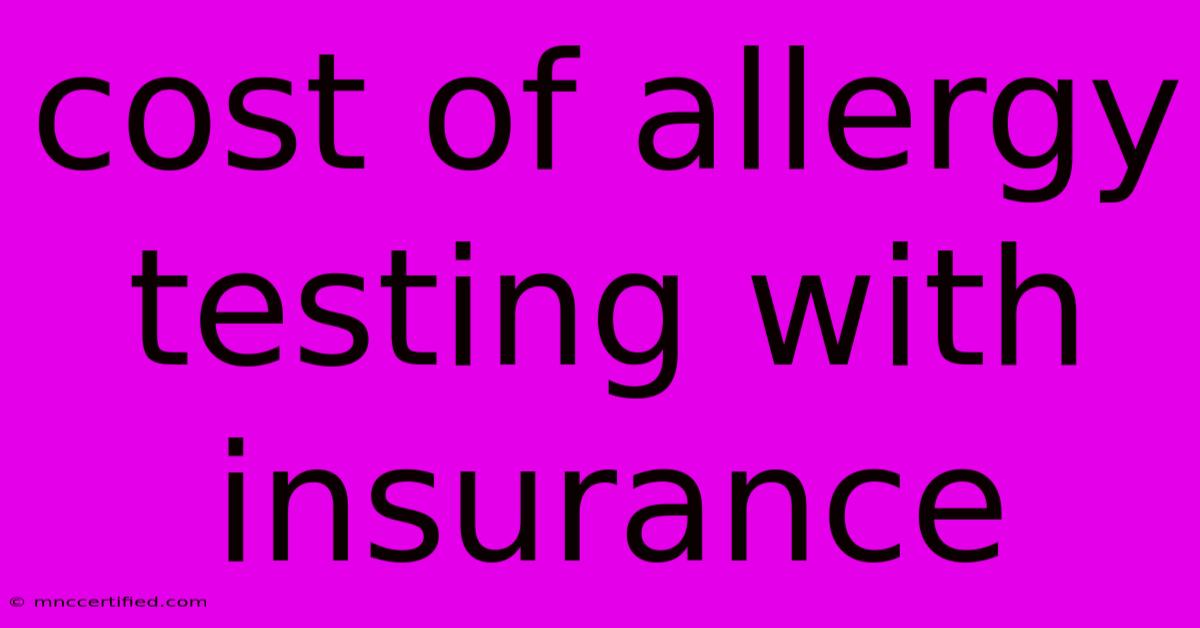Cost Of Allergy Testing With Insurance

Table of Contents
Unraveling the Cost of Allergy Testing with Insurance: A Comprehensive Guide
Dealing with allergies can be a frustrating and confusing experience. Figuring out the triggers and finding effective treatments can feel like a never-ending quest. Allergy testing often plays a crucial role in this journey, helping to identify the culprits behind your symptoms. However, a common concern arises: how much does allergy testing cost, and will my insurance cover it?
This comprehensive guide will shed light on the costs associated with allergy testing, delve into the intricacies of insurance coverage, and equip you with the knowledge to navigate this process effectively.
What Factors Influence Allergy Testing Costs?
The cost of allergy testing can vary significantly depending on several factors:
- Type of Allergy Testing: Different tests are available, each with its own price tag.
- Skin Prick Testing: This common method involves pricking the skin with a small amount of allergen. It's generally the most affordable option.
- Blood Tests: These tests analyze your blood for allergy-specific antibodies, often used for detecting allergies to specific foods or inhalants.
- Challenge Testing: This method involves controlled exposure to an allergen to assess your reaction. It's usually reserved for specific cases and can be more expensive.
- Number of Allergens Tested: The more allergens you need to be tested for, the higher the cost.
- Location of Testing: Costs can fluctuate depending on the geographical location and the facility where you get tested.
- Doctor's Fees: Your allergist's fees may be separate from the cost of the testing itself.
Navigating Insurance Coverage for Allergy Testing
While insurance plans vary widely, most will cover at least a portion of the cost of allergy testing. Here's what you need to know:
- Check Your Coverage: Begin by contacting your insurance provider to understand your specific plan's benefits. Pay close attention to:
- Deductible: The amount you need to pay out-of-pocket before your insurance kicks in.
- Co-pay: A fixed amount you pay per test or service.
- Co-insurance: A percentage of the cost you're responsible for after meeting your deductible.
- Pre-authorization: Some tests may require prior approval from your insurance company.
- Choose an In-Network Provider: Opting for an allergist who is in your insurance network can significantly reduce your out-of-pocket expenses.
- Consider a Health Savings Account (HSA): If you have an HSA, you can use the funds to cover eligible medical expenses like allergy testing.
Reducing Your Allergy Testing Costs: Strategies and Tips
- Negotiate with Your Doctor: Sometimes, you can negotiate a payment plan with your allergist or inquire about discounted rates.
- Seek Financial Assistance: Organizations like the Allergy & Asthma Foundation of America (AAFA) offer financial assistance programs for those struggling to afford allergy testing.
- Explore Alternatives: While allergy testing can be crucial for diagnosis, consider exploring other avenues to identify potential allergens. Keeping a detailed food diary, for example, can help pinpoint food triggers.
Conclusion
Understanding the costs associated with allergy testing and navigating insurance coverage can feel daunting. This guide provides a comprehensive framework to equip you with the knowledge you need. By understanding the factors influencing costs, checking your coverage, and considering alternative options, you can navigate the path to allergy diagnosis with greater clarity and control.

Thank you for visiting our website wich cover about Cost Of Allergy Testing With Insurance. We hope the information provided has been useful to you. Feel free to contact us if you have any questions or need further assistance. See you next time and dont miss to bookmark.
Featured Posts
-
Zara Receives Order Of Friendship In Russia
Nov 09, 2024
-
Insurance For Passenger Transportation
Nov 09, 2024
-
Safety Alert Cheese Recall Affects Several Stores
Nov 09, 2024
-
Pet Shop Boys Release All The Young Dudes Cover
Nov 09, 2024
-
Voya Accident Insurance Payout Amounts
Nov 09, 2024